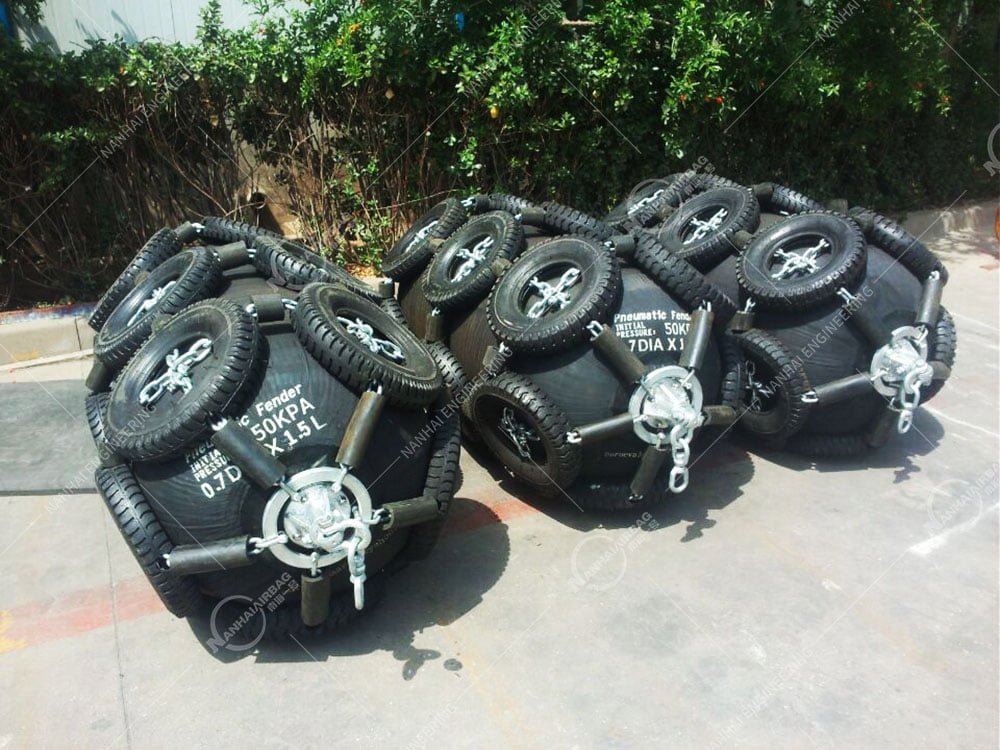Ocean Defender
02/07/2025Hydro-Pneumatic Fenders
02/10/2025Maintaining Pneumatic Fenders

Maintaining pneumatic fenders is crucial to ensure their reliability and performance in protecting ships and structures during docking, mooring, or other maritime operations. Pneumatic fenders are inflatable devices that absorb the kinetic energy of ships when they come into contact with port structures or other vessels. Proper maintenance can extend their lifespan and ensure they function effectively. Here’s a guide on how to maintain pneumatic fenders:
1. Routine Visual Inspections
- Inspect the Exterior: Regularly check the fender’s external surface for signs of wear, cuts, abrasions, or punctures. Any damage can reduce the fender’s performance.
- Check for Dents or Deformations: Examine the fender for any visible signs of deformation, especially in the areas that take the most pressure. This could indicate an internal failure or excessive wear.
- Inspect the Valve and Inflation Equipment: Check the inflation valve and associated equipment for any leakage or damage. Ensure that the valve is functioning properly for easy inflation and deflation.
2. Pressure Check and Inflation
- Regularly Check the Inflation Pressure: The correct air pressure ensures that the fender provides adequate protection. Follow the manufacturer’s guidelines for the recommended inflation pressure.
- Under-inflation can cause the fender to compress too much upon impact, reducing its shock absorption capability.
- Over-inflation can make the fender too rigid and prone to bursting under extreme stress.
- Use a Pressure Gauge: Always use a calibrated pressure gauge to verify the internal pressure. Perform checks on a scheduled basis (e.g., weekly or monthly).
3. Cleaning the Fender
- Wash with Fresh Water: Clean the fender periodically with fresh water to remove salt, dirt, or debris that may accumulate over time. Saltwater residue can cause corrosion and weaken the fender material.
- Use Mild Detergents: For tougher stains, use a mild detergent mixed with fresh water. Avoid harsh chemicals or solvents that could damage the fender material (typically rubber or synthetic material).
- Dry Properly: After cleaning, allow the fender to dry fully before storing it or re-inflating it. This prevents mold, mildew, or algae growth.
4. Check the Fender Accessories
- Check the Chain and Shackle Connections: Inspect any chain, shackles, and other hardware attached to the fender for signs of rust, wear, or breakage. These components should be securely fastened to ensure the fender stays in place during use.
- Inspect the Netting or Cover: Some fenders have netting or protective covers to enhance durability. Check for any holes or tears that could expose the fender to damage.
5. Storage
- Deflate When Not in Use: If the fender is not in use for a long period (e.g., during the off-season), deflate it partially to relieve pressure and reduce the risk of damage.
- Store in a Cool, Dry Place: Store fenders in a shaded, dry area when not in use. Avoid exposing them to direct sunlight for prolonged periods, as UV rays can degrade the materials.
- Avoid Sharp Objects: Ensure that the storage area is free from sharp objects or debris that could puncture or damage the fender.
6. Repairs and Patch Kits
- Minor Damage: For small punctures or damage, use a repair patch kit that is compatible with the material of your pneumatic fender. Most kits contain rubber patches or adhesives that can seal up minor cuts or holes.
- Ensure Proper Surface Preparation: Clean and dry the area around the damage before applying the patch to ensure proper adhesion.
- Professional Repair for Major Damage: If the damage is significant (large punctures, deep cuts, or tears), it is advisable to contact the manufacturer or a professional repair service to fix the fender. Continuing to use a damaged fender can lead to further degradation and potential failure.
7. Inspection After Use
- Post-Operation Inspections: After the fender has been used in an operation (e.g., docking or mooring), conduct an immediate inspection. Check for any signs of pressure loss, wear, or damage from impacts.
- Check the Fender’s Shape and Functionality: Ensure the fender maintains its proper shape and performs its intended function of absorbing shock and preventing damage.
8. Regular Maintenance Schedule
- Establish a Maintenance Routine: Create a maintenance schedule that includes routine checks for pressure, visual inspections, cleaning, and post-use evaluations. A proactive approach helps to catch potential issues before they become serious problems.
- Record Keeping: Keep a log of inspections, maintenance activities, and any repairs done. This documentation can be useful for tracking the fender’s condition and for warranty or insurance purposes.
9. Professional Servicing
- Annual Professional Inspection: Even with regular maintenance, it’s advisable to have pneumatic fenders professionally inspected once a year. Technicians can identify internal issues, such as wear to internal components or signs of deterioration in the inflatable structure.
- Replace Damaged Fenders: If a pneumatic fender is found to be beyond repair or is not performing properly, it should be replaced with a new one. An underperforming fender can compromise the safety of docking operations.
Conclusion
Maintaining pneumatic fenders is crucial for ensuring their long-term effectiveness in protecting ships and infrastructure during docking and mooring. By conducting regular inspections, cleaning, checking inflation pressure, and making necessary repairs, you can maximize the lifespan of the fender and ensure it continues to provide reliable protection. Always refer to the manufacturer’s guidelines for specific maintenance instructions and consider professional servicing for more extensive repairs or checks.
